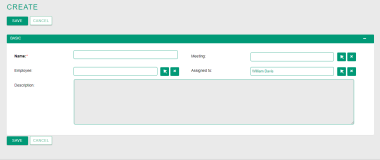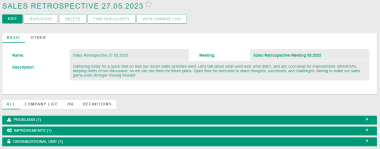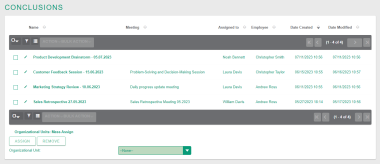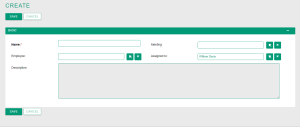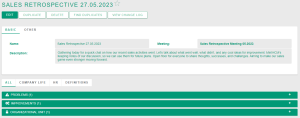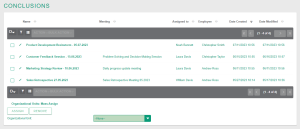Difference between revisions of "Module:Conclusions"
| (One intermediate revision by one other user not shown) | |||
| Line 10: | Line 10: | ||
|Module-reportable=Yes | |Module-reportable=Yes | ||
|Module-hidden=No | |Module-hidden=No | ||
| − | |Short Description=MintHCM's Conclusions module is a | + | |Related Screens=File:MintHCM - Conclusions - createView.png,File:MintHCM - Conclusions - detailView.png,File:MintHCM - Conclusions - listView.png |
| + | |Short Description=MintHCM's Conclusions module is a tool for managing and recording conclusions within your organization. This module provides features for articulating, tracking, and linking conclusions to related records, including Improvements and Problems. | ||
}} | }} | ||
| − | |||
=={{int:ev-business_description}}== | =={{int:ev-business_description}}== | ||
==== Overview ==== | ==== Overview ==== | ||
| − | The Conclusions module in MintHCM | + | The Conclusions module in MintHCM offers a flexible space designed for users to capture and manage various conclusions within the system. It serves as a tool allowing individuals to document and monitor conclusions, providing a platform for transparent communication among teams. It's important to note that the module isn't prescriptive about the type of information users can input—it's entirely up to them. They can record any relevant conclusions, connect them to specific meetings or employees, and assign responsible users. The module's purpose is to facilitate documentation of some loose thoughts within the system, offering fields designed to capture all related details. Users have the liberty to decide what information to input, as the module's design supports adaptability to diverse organizational needs. |
| − | |||
| − | |||
| − | |||
| − | |||
==== Fields ==== | ==== Fields ==== | ||
| Line 46: | Line 42: | ||
==== Relations ==== | ==== Relations ==== | ||
| − | The | + | The Conclusions module establishes connections with the [[Module:Improvements|Improvements]] and [[Module:Problems|Problems]] modules, allowing users to link conclusions to specific improvement initiatives or problems that has been identified and documented within the system. Apart from that Conclusions module records can be related to a particular [[Module:Meetings|meetings]] where these conclusions were drawn or discussed, providing a direct correlation between the conclusion and the relevant meeting. |
| − | |||
| − | |||
| − | |||
| − | |||
| − | |||
| − | |||
| − | |||
| − | |||
| − | |||
{{Module-links}} | {{Module-links}} | ||
{{technical-description}} | {{technical-description}} | ||
{{DevNotes}} | {{DevNotes}} | ||
Latest revision as of 10:27, 5 January 2024
| Conclusions | |
|---|---|
| Name: | Conclusions |
| Tech Name: | Conclusions |
| Class Name: | Conclusions |
| Type: | Standard |
| Template: | Security_groups, Assignable, Basic |
| Custom Module: | No |
| Auditable: | Yes |
| Importable: | No |
| Reportable: | Yes |
| Hide module on Main Page: | No |
Contents
Short Description
MintHCM's Conclusions module is a tool for managing and recording conclusions within your organization. This module provides features for articulating, tracking, and linking conclusions to related records, including Improvements and Problems.
Business Description
Overview
The Conclusions module in MintHCM offers a flexible space designed for users to capture and manage various conclusions within the system. It serves as a tool allowing individuals to document and monitor conclusions, providing a platform for transparent communication among teams. It's important to note that the module isn't prescriptive about the type of information users can input—it's entirely up to them. They can record any relevant conclusions, connect them to specific meetings or employees, and assign responsible users. The module's purpose is to facilitate documentation of some loose thoughts within the system, offering fields designed to capture all related details. Users have the liberty to decide what information to input, as the module's design supports adaptability to diverse organizational needs.
Fields
The Conclusions module is comprised of multiple fields, each meticulously crafted with a distinct purpose in mind, serving to capture and organize essential conclusions-related information. Here is a detailed explanation of each field:
| Name | The concise title or description of the conclusion. | |
| Meeting | The meeting related with the conclusion record. | |
| Employee | The Employee related with the conclusion record. | |
| Assigned User | The user designated to manage or handle the assigned conclusion. | |
| Date Created | The date and time when the conclusion was initially created. | |
| Date Modified | The date and time when the conclusion was last edited or modified. |
Note: Fields marked with an asterisk are required. Saving the record without providing input to them beforehand won't be possible.
Relations
The Conclusions module establishes connections with the Improvements and Problems modules, allowing users to link conclusions to specific improvement initiatives or problems that has been identified and documented within the system. Apart from that Conclusions module records can be related to a particular meetings where these conclusions were drawn or discussed, providing a direct correlation between the conclusion and the relevant meeting.
Custom Actions
Processes
Related Processes
Related Process Steps
Related Features
Affected by
Initiating
Related Integrations
Structure
Fields
| Name | Type | Required | Validations | Visible | Editable |
|---|---|---|---|---|---|
| Assigned to | relate | No | Yes | Yes | |
| Created by | relate | No | Yes | No | |
| Date Created | datetime | No | Yes | No | |
| Date Modified | datetime | No | Yes | No | |
| Description | text | No | Yes | Yes | |
| Meeting | relate | No | Yes | Yes | |
| Modified by Name | relate | No | Yes | No | |
| Name | name | Yes | Yes | Yes |
Relationships
| Laft | Type | Right | Short Description | Relationship |
|---|---|---|---|---|
| Meetings | one-to-many | Conclusions | One Meeting record can have many related Conclusions records, but a specific Conclusions record can be related to only one Meeting record. | Relationship: Meetings - Conclusions |
| Users | one-to-many | Conclusions | Specific Sugar user can modify many account records, but specific account record last modification was performed by specific user. | Relationship: Users - Conclusions |
| Users | one-to-many | Conclusions | Specific Sugar user can create many account records, but specific account record can be created by only one user. | Relationship: Users - Conclusions |
| Users | one-to-many | Conclusions | Specific Sugar user can be assigned to many account records, but specific account record can only have one user assigned. | Relationship: Users - Conclusions |
